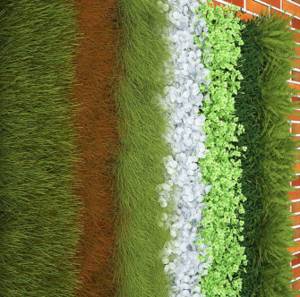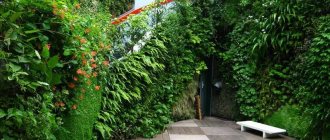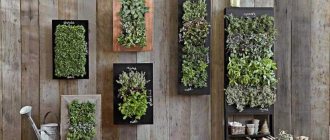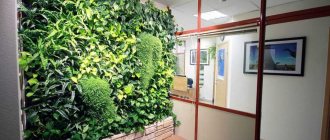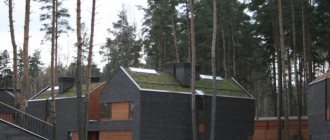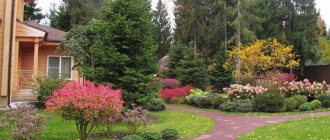What is phytowall
The phytomodule and phytowall in the interior are a ready-to-use structure on a plastic or other durable base, with fresh flowers and decorative elements planted in special recesses.
At your discretion, the structure can be equipped with an automatic watering system, connection to an alarm system or a smart home panel. The parameters of such decor can vary from 0.5 to 5 m2, depending on the size of the home and the financial capabilities of the owners.
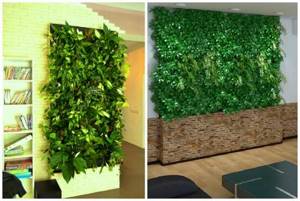
How to water plants in a phytomodule
For convenience, you can create phytomodules with automatic watering for vertical gardening. They involve the creation of an automatic drip irrigation system by equipping the structure with drippers for roots and drippers for irrigating foliage. The photo shows one of the options for an automatic irrigation system.
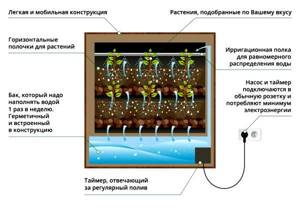
As a rule, each block contains a valve that allows accumulated water to be drained in case of overflow. If you decide to place a couple of blocks on your green wall containing special mounting frames, it is better to install a six-block plant drip system. Up to this amount, it will be easier to organize watering using a manual five-liter pump: this way you can supply moisture to vegetation that is located at a height of approximately two and a half meters.
Immediately after planting, adjust the optimal frequency of watering. Start by watering for half an hour twice a day. After a couple of days you will be able to find out whether this amount of moisture is enough.
Please note that in order to preserve the appearance of such a green wall, as well as to maintain the health of the varieties, it is important not only to water them in a timely manner, but also to prune and remove shoots that are damaged.
If the phytomodules are manufactured correctly and proper care of the greens is provided, you will be able to enjoy the benefits of this design for a long time. Since it will play not only a practical, but also an aesthetic role, do not forget to look at the photo of vertical gardening at your dacha with your own hands - and choose a method for decorating a homemade installation.
Types of decorative details of a “green wall”
Modern interior design has many faces. There are several types of phytowall in an apartment:
- Vertical phytowall. This is a voluminous, integral composition in which plants are placed in niches designated for them. Often these are “green” islands, which are located in one place and do not require movement.
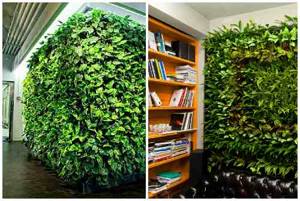
- Phytomodules for vertical gardening are made according to the previous system, but their main difference is their compactness and the ability to be transported from place to place.
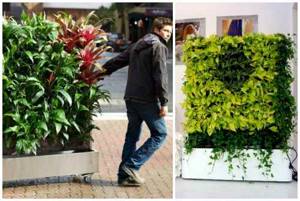
- "Green Picture" These are small-sized elements, and their use is similar to the use of ordinary artistic canvases.
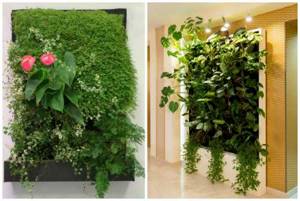
- Mobile phytowall. It is used in the form of a self-sufficient screen or even a door when using territory zoning. Due to the specific use of decor, its service life is shorter than that of vertical gardening. However, such a fence can enliven any home and arouse the interest and admiration of guests.
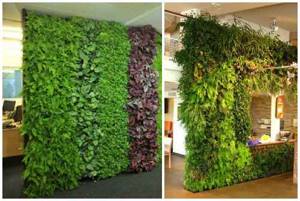
- Ceiling type. The name determines its location. The ceiling or its sections are decorated. Often used in the kitchen or winter garden.
Interesting! The choice of shape depends only on your idea. The basis for flights of fancy and the arrangement of greenery can be columns, cube paintings, and round flower beds.

Plants for vertical gardening.
Fern.
Ferns are one of the best options for vertical gardening due to their adaptability and moisture resistance. Ferns are easy to grow and will quickly create a lush cover. Because Ferns usually grow downward, so you need to combine them with other plants that have a vertical shape.
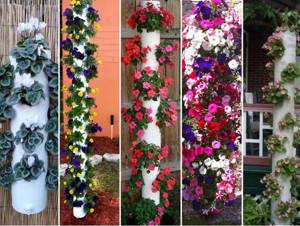
Bromeliads.
Most bromeliads have shallow roots and don't need much space to grow and thrive - making them ideal plants for vertical gardens. Their colorful leaves and long flowering period can be a good addition to your vertical garden.
Begonias.
If you are setting up your vertical garden in a location that receives little sunlight, then growing begonias is a good idea.

Hosts.
This beautiful plant with variegated foliage is used as a ground cover in gardens. Hostas are suitable for vertical gardening in a shady area.
Succulents.
Succulents are the most popular plants for vertical gardening due to their incredible adaptability and resistance to temperature fluctuations and climate change.
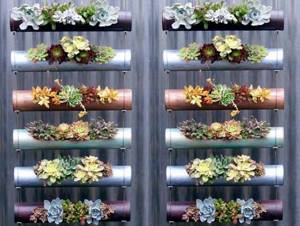
Epiphytes.
These plants don't need soil to grow - they naturally grow on other plants, making them ideal for growing in vertical gardens.
Lianas.
The most common vines grow well in vertical gardens. They do not require significant care and develop well with a lack of sunlight.
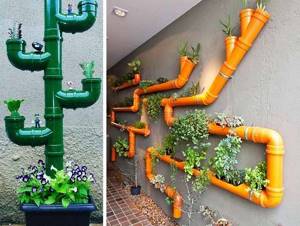
Advantages of using “green” modules
This design has many advantages not only from an aesthetic point of view, but also from a practical point of view:
- natural conditioner due to the ability of greenery to absorb “dirt”;
- it can be installed anywhere for all dimensions of the apartment;
- environmental friendliness, high safety and health improvement;
- the ability to regulate the level of humidity in the room;
- unlimited design possibilities;
- increasing the efficiency and concentration of the occupants of the premises;
- the ability to hide interior defects in the form of wires, ceilings and blind areas.
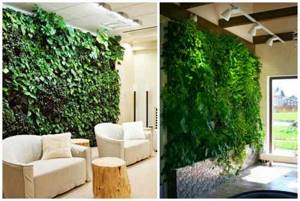
Features and advantages of such installations
The phytomodule is a frame structure, vertically placed on the wall and closely planted with living plants. Thanks to the use of soil in the pockets of phytomodules and the organization of a watering system for each plant, such a wall has a long service life, so you can enjoy a homemade natural corner in your apartment, house or garden for a long time.
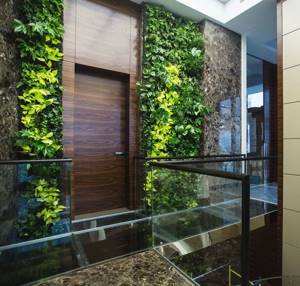
The popularity of vertical gardening in landscape design and in the home is due to the many advantages of such designs:
- By growing real plants, you can ensure that the air is constantly cleared of pollutants. As a result, the well-being of everyone who will live in such a room or area will improve;
- natural accents will never be superfluous and will fit into the finished design, and you can easily “revive” a boring environment and add bright colors;
- in the summer, phytomodules will play the role of a natural air conditioner and cool the air;
- Thanks to vertical gardening in the garden, you can highlight different functional areas and create stylish transitions between them. For example, a good option for a spacious area would be vertical gardening of a fence;
- a wall of greenery can prevent dust, wind, and rays from entering the area;
- By attaching such structures to the facades of buildings, you can reduce heat loss and reduce noise in the room.
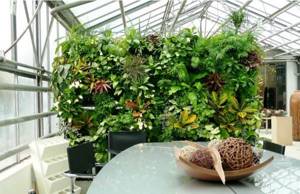
And, of course, we should not forget about the relaxing role of such green areas. You can look at photos of vertical gardening and choose the design option that you like. It will not be difficult to carry out all the installation work yourself, and in a short time you will not only improve the living area, but also provide complete conditions for relaxation.

How to care for a module or wall with plants
An artificial phytowall needs less maintenance, but a real one creates a special mood and atmosphere in the apartment.
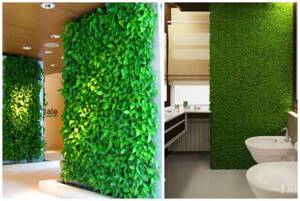
- If necessary, do not forget to add liquid to the pockets if you decide not to install automatic watering.

- If your choice falls on a model with automatic watering, then at first pay close attention to the watering schedule - make sure that water is always freely available.
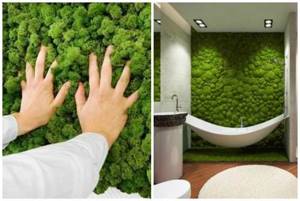
- Remove dry and dead leaves in a timely manner.
- A mixture of mineral fertilizers is the best feeding.
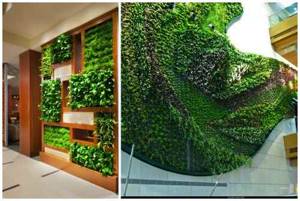
- Trim overgrown shoots.
- Check the serviceability of the pump and irrigation pipe.

A phytowall made of moss and flowers is simple to make, and at the same time the result is beautiful and original. You will spend many pleasant moments next to this decorative element, you will be able to improve your health and get a charge of vigor and strength.
DIY mini garden
How to make vertical gardening for a mini-garden? To build a small phytowall, which is suitable not only for a summer house, but also for apartments or balconies, you will need three gutters, plugs for them, a steel cable, clamps with hooks, semicircular steel rods, as well as self-adhesive tape and soil.
Make holes in the gutter for drainage. Drill two smaller holes along the edges and pull the steel torso through them. Place self-adhesive tape inside. Pass the cable through the holes and secure with clamps. To do this, insert a steel rod into the clamp: this way you can ensure the reliability and durability of the entire structure.
The photo below shows a diagram of such a vertical flower garden.
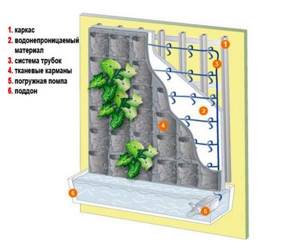
Choose a place to secure the mini-garden - and hook the hooks, keeping a distance between each, similar to the distance between the cables. If they do not match, the structure will bend. For two or three levels, run the cables through a couple of gutters.
Place expanded clay and stones on the base for drainage, and then make a layer of soil - and begin planting vegetation.
Remove the small plant from the pot, carefully remove the soil, wash the roots and trim off the ends by a couple of centimeters. Sprinkle the sections with crushed activated carbon.
Use sphagnum moss as a moisture-retaining substrate. It will play a bactericidal role and prevent the spread of fungus. Moisten the sphagnum with warm water, which has settled before, carefully wrap the roots in it - and place the vegetation in the module.
You shouldn’t leave a lot of space between plants: empty areas can be covered with moss.
Vertical gardens by Patrick Blanc
The technology for creating vertical gardens was created by Patrick Blanc , a naturalist designer from France. The basis of Blanc's first garden is a metal frame covered with polymer felt, through which moisture and nutrients needed by plants rise. Seedlings are planted in this structure.
Patrick Blank has developed a system in which plants thrive without pots of soil, they are fed by a high-altitude irrigation system. The thickness of the structure is several centimeters, and the weight is 1 square meter. meter - no more than 30 kg.
Blank came to create the gardens while studying the forests of Malaysia. He concluded that several thousand plants can take root on rocks and mountains where there is enough light, moisture and minerals. This is what led him to the idea of creating green compositions on the walls of houses.
Patrick conducted his first experiments with plants at the age of 12; he planted flowers in ordinary soil. While working at a national research center, he conducts research on plants and minerals.
The first vertical composition was demonstrated in 1994 at the Paris landscape design festival; it attracted the attention of hundreds of specialists and was recognized as an example of new trends in the art of decoration. After this, Blanc began to receive orders from famous decorators and architects. For example, Patrick, at the request of Andre Putman, created a 30-meter green cascade of irises, white carnations, ferns and begonias. Today, vertical gardens created using the Blanche system decorate museums, parking lots, coping centers, hotels, restaurants and administrative buildings around the world.
The main principle of Monsieur Blanc is to never repeat yourself and always find new solutions. “I try to harmoniously combine nature with the city,” explains the designer.
Which plants to choose for decorating a phytowall?
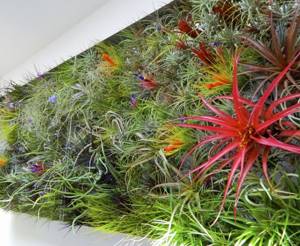
On the one hand, a win-win option would be to focus on your own taste, and on the other hand, there is a list of plants that are most adapted to such living conditions. The following families recommend decorating a phytowall in an apartment with your own hands:
- Hypoxidium. This is an indoor plant, characterized by long leaves and quite impressive height. For hypoxidiums, it is advisable to arrange a phytowall with large spaces between the pockets, since crowding will have a bad effect on their development.
- Marantaceae. On the contrary, they are small plants that are optimal for planting in a small area. Marantaceae tolerate moderate humidity and dark rooms well.
- Ferns. In this family, it is worth choosing pellea, pteris and nephrolepis. These varieties have a bright and lush top, which looks playful and airy in the composition. What is also important is that fern, unlike many indoor plants, is resistant to nearby heating sources.
- Bromeliads. Flowering plants that can be used in combination with green spaces. Features include undemandingness in terms of watering. From time to time, it is enough to wet the stems and leaves with a spray bottle.
- Ivy. One of the most successful options from the point of view of use in a phytomodule. All types of ivy are characterized by low requirements for moisture, light and air. Therefore, if necessary, with the help of such a design it will be possible to zone “problem” areas near the corridor, bathroom and kitchen.
Of course, it is not necessary to plant only one type of plant. The phytomodule is quite suitable for combined solutions if, in principle, there can be compatibility between different varieties.
